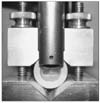1. Bearn DR. Bonded orthodontic retainers: a review. Am J Orthod Dentofacial Orthop. 1995. 108:207–213.

2. Oesterle LJ, Shellhart WC, Henderson S. Enhancing wire-composite bond strength of bonded retainers with wire surface treatment. Am J Orthod Dentofacial Orthop. 2001. 119:625–631.

3. Ramoglu SI, Usumez S, Buyukyilmaz T. Accelerated aging effects on surface hardness and roughness of lingual retainer adhesives. Angle Orthod. 2008. 78:140–144.

4. Lutz F, Krejci I, Barbakow F. Quality and durability of marginal adaptation in bonded composite restorations. Dent Mater. 1991. 7:107–113.

5. Eick JD, Welch FH. Polymerization shrinkage of posterior composite resins and its possible influence on postoperative sensitivity. Quintessence Int. 1986. 17:103–111.
6. De Munck J, Van Landuyt K, Peumans M, Poitevin A, Lambrechts P, Braem M, et al. A critical review of the durability of adhesion to tooth tissue: methods and results. J Dent Res. 2005. 84:118–132.

7. Breschi L, Mazzoni A, Ruggeri A, Cadenaro M, Di Lenarda R, De Stefano Dorigo E. Dental adhesion review: aging and stability of the bonded interface. Dent Mater. 2008. 24:90–101.

8. Hilton TJ. Can modern restorative procedures and materials reliably seal cavities? In vitro investigations. Part 1. Am J Dent. 2002. 15:198–210.
9. Hilton TJ. Can modern restorative procedures and materials reliably seal cavities? In vitro investigations. Part 2. Am J Dent. 2002. 15:279–289.
10. Irie M, Suzuki K, Watts DC. Marginal gap formation of light-activated restorative materials: effects of immediate setting shrinkage and bond strength. Dent Mater. 2002. 18:203–210.

11. Gladwin MA, Bagby MD. Clinical aspects of dental materials: theory, practice, and cases. 2004. Philadelphia, Pa: Lippincott Williams & Wilkins;47–57.
12. Guggenberger R, Weinmann W. Exploring beyond methacrylates. Am J Dent. 2000. 13:82D–84D.
13. Weinmann W, Thalacker C, Guggenberger R. Siloranes in dental composites. Dent Mater. 2005. 21:68–74.

14. Thalacker C, Heumann A, Weinmann W, Guggenberger R, Luchterhandt T, Syrek A. Marginal integrity of class V silorane and methacrylate composite restorations. J Dent Res. 2004. 83:A1364. Spec Iss A.
15. Palin WM, Fleming GJ, Nathwani H, Burke FJ, Randall RC. In vitro cuspal deflection and microleakage of maxillary premolars restored with novel low-shrink dental composites. Dent Mater. 2005. 21:324–335.

16. Gillgrass TJ, Millett DT, Creanor SL, MacKenzie D, Bagg J, Gilmour WH, et al. Fluoride release, microbial inhibition and microleakage pattern of two orthodontic band cements. J Dent. 1999. 27:455–461.

17. James JW, Miller BH, English JD, Tadlock LP, Buschang PH. Effects of high-speed curing devices on shear bond strength and microleakage of orthodontic brackets. Am J Orthod Dentofacial Orthop. 2003. 123:555–561.

18. Baysal A, Uysal T, Ulker M, Usumez S. Effects of high-intensity curing lights on microleakage under bonded lingual retainers. Angle Orthod. 2008. 78:1084–1088.

19. Uysal T, Ulker M, Baysal A, Usumez S. Different lingual retainer composites and the microleakage between enamel-composite and wire-composite interfaces. Angle Orthod. 2008. 78:941–946.

20. Uysal T, Baysal A, Usumez S, Ulker M. Microleakage between composite/wire and composite/enamel interfaces of flexible spiral wire retainers. Part 1: a comparison of three composites. Eur J Orthod. 2009. 31:647–651.

21. Uysal T, Ulker M, Baysal A, Usumez S. Microleakage between composite-wire and composite-enamel interfaces of flexible spiral wire retainers. Part 2: comparison of amorphous calcium phosphate-containing adhesive with conventional lingual retainer composite. Eur J Orthod. 2009. 31:652–657.

22. Ulker M, Uysal T, Ramoglu SI, Ertas H. Microleakage under orthodontic brackets using high-intensity curing lights. Angle Orthod. 2009. 79:144–149.

23. Uysal T, Ulker M, Ramoglu SI, Ertas H. Microleakage under metallic and ceramic brackets bonded with orthodontic self-etching primer systems. Angle Orthod. 2008. 78:1089–1094.

24. Bearn DR, McCabe JF, Gordon PH, Aird JC. Bonded orthodontic retainers: the wire-composite interface. Am J Orthod Dentofacial Orthop. 1997. 111:67–74.

25. Taylor MJ, Lynch E. Microleakage. J Dent. 1992. 20:3–10.

26. Alani AH, Toh CG. Detection of microleakage around dental restorations: a review. Oper Dent. 1997. 22:173–185.
27. Reynolds IR. A review of direct orthodontic bonding. Br J Orthod. 1975. 2:171–178.

28. Artun J. Caries and periodontal reactions associated with long-term use of different types of bonded lingual retainers. Am J Orthod. 1984. 86:112–118.

29. Oliver RG. The effect of different methods of bracket removal on the amount of residual adhesive. Am J Orthod Dentofacial Orthop. 1988. 93:196–200.

30. O'Reilly MM, Featherstone JD. Demineralization and remineralization around orthodontic appliances: an in vivo study. Am J Orthod Dentofacial Orthop. 1987. 92:33–40.
31. Ogaard B, Rølla G, Arends J. Orthodontic appliances and enamel demineralization part 1 Lesion development. Am J Orthod Dentofacial Orthop. 1988. 94:68–73.




 PDF
PDF ePub
ePub Citation
Citation Print
Print









 XML Download
XML Download